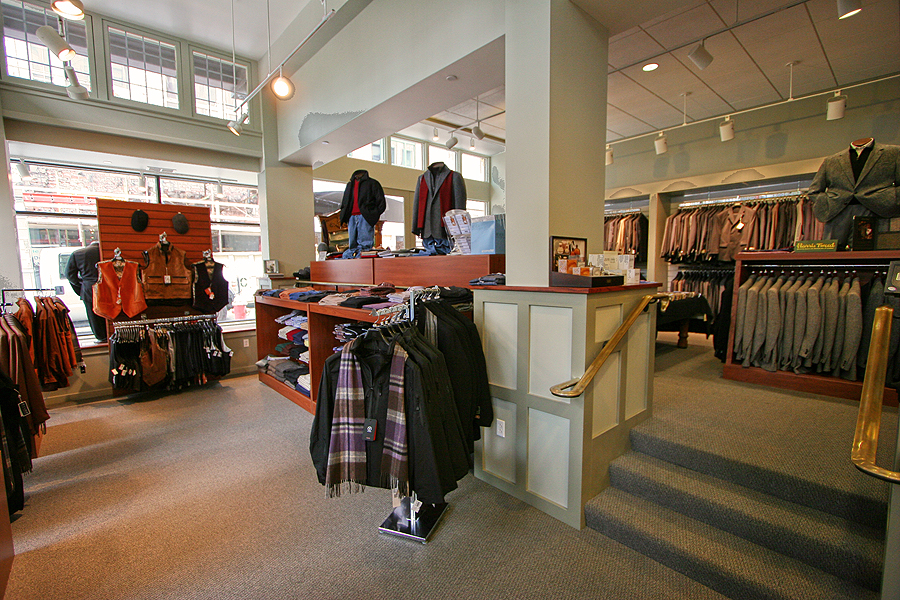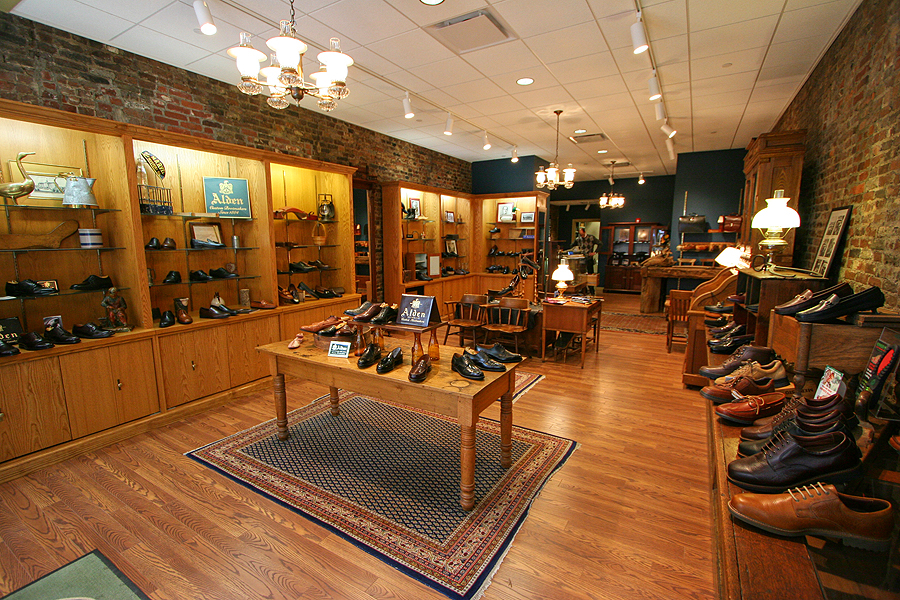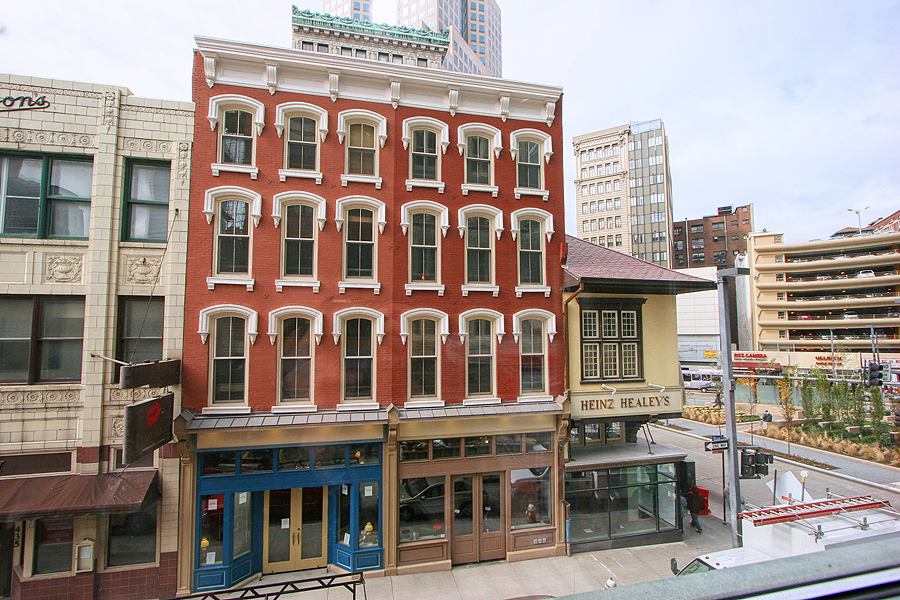
Category Archive: Neighborhood Development
-
Westmoreland County Students Propose New Uses for Historic Vacant Building in Monessen, PA
PHLF News
by PHLF Intern William Prince
April 1, 2010On March 22 & 23, 2010, PHLF and the Greater Monessen Historical Society hosted the 14th Annual Architectural Design Challenge for schools in Westmoreland County. Over 100 middle school and 40 high school students participated, from Belle Vernon, Franklin Regional, Greensburg Salem, Laurel Valley, Ligonier Valley, Monessen, Penn Trafford, Valley, and Yough school districts.
The students began this project in October 2009 by visiting the design site in Monessen, PA. They were assigned the task of (1) building a model showing a new use for the vacant and historic Monessen Savings & Trust Building of 1904-06 and (2) drawing a streetscape showing design improvements for the 500 Block of Donner Avenue. Through this experience, they learned about the history, architecture, and unique character of Monessen, PA.
Twenty-six teams presented their work on March 22 and 23, 2010 to a jury of architects, urban planners, and interior designers. The event was held at Monessen Senior High School and awards were presented. Students described their concepts during a 6-minute oral presentation and then entertained questions and comments from the judges.
Models showed the former Monessen Savings & Trust Building repurposed as a place of activity and entertainment housing a variety of new uses: a community center, sports emporium, day-care and tutoring center, candy store and yoga center, restaurant/hotel/coffee shop, family fun center, arts and music center, roller rink, physical therapy and exercise studio, and under-21 dance club, among other ideas. Many teams included “green-building” concepts such as roof top gardens, “living” walls, solar panels, Energy-star appliances––but the greenest feature of most models was reusing the existing building.
The judges were impressed with the students’ concepts and with the models they built to scale. Walls were constructed out of foam core, wood, or cardboard, and furniture and architectural details were crafted out of many materials, including clay. One team even created a pond filled with real fish in the vacant lot adjacent to the Monessen Savings & Trust Building.
The students learned a lot about teamwork and time management––and they gained an appreciation for the architecture and the history of main street communities. “Before this project I found the former Savings & Trust Building to be an eyesore,” said one student. “Now, I look at it as a structure that only needs to be renovated” and brought back to life for the city of Monessen.
The following photos show the project site in Monessen and some of the projects presented on March 22 & 23, 2010.
Tribune Review Article
Architectural Design Challenge Process
-
Market at Fifth Receives National Housing & Rehabilitation Association Award
PHLF News
November 3, 2009The National Housing & Rehabilitation Association (NH&RA) recently presented its 2009 J. Timothy Anderson Awards for Excellence in Historic Rehabilitation to ten outstanding historic rehabilitation projects throughout theU.S. The awards were presented at a special luncheon during NH&RA’s 2009 Annual Fall Developers Forum conference at the Taj Hotel to honor outstanding real estate projects that involved rehabilitation of older, historic buildings using the federal historic rehabilitation tax credit. This year’s nominees competed in eight categories.
This year’s categories, and the winners in each, are as follows:
Best Mixed-Income Residential
Baker Square II, Dorchester, MA
Developer: WinnDevelopment, Boston, MA
Architect: The Architectural Team, Chelsea, MABest Market-Rate Residential
Market at Fifth, Pittsburgh, PA
Developer: Market at Fifth, LP, Pittsburgh, PA
Architect: Landmarks Design Associates, Pittsburgh, PABest Historic Rehabilitation Project Utilizing New Markets Tax Credits
Court Square Center, Memphis, TN
Developers: CGI & Partners Court Square Center, LLC, Memphis, TC
Telesis Corporation, Washington, DCArchitect: CM Design Corporation, Memphis, TN
Best Commercial / Retail / Non-Residential Project
The Old Cotton Factory, Rock Hill, SC
Developer: Barwick & Associates, Charlotte, NC
Architect: McClure Nicholson Montgomery Architects, Charlotte, NCBest Historic Rehabilitation Project Involving New Construction
Globe Mills, Sacramento, CA
Developer: C.F.Y. Development Incorporated, Sacramento, CA
Architect: Applied Architecture, Inc., Sacramento, CAMost Innovative Adaptive Reuse
Charles H. Shaw Technology & Learning Center, Chicago, IL
Developer: Homan Arthington Foundation, Chicago, IL
Architect: Farr Associates, Chicago, ILBest Historic Rehabilitation Project Utilizing Low-Income Housing Tax Credits – Large
Toward Independent Living & Learning (TILL), Chelsea, MA
Developer: Toward Independent Living & Learning, Dedham, MA
Architect: Mostue & Associates Architects, Somerville, MABest Historic Rehabilitation Project Utilizing Low-Income Housing Tax Credits – Small
Fairbanks Flats Rowhomes, Beloit, WI
Developer: Gorman & Company, Inc., Oregon, WI
Architect: Gorman & Company, Inc., Oregon, WIThe “Timmy” Awards were created by NH&RA in 2005 in memory of the late Boston architect and preservation advocate J. Timothy Anderson, a leader in the historic rehabilitation business. Throughout his career, Tim helped pioneer the adaptive reuse of historic buildings throughout Boston and other parts of the U.S. Tim’s notable Boston-area projects include the conversion of the Prince Spaghetti Building into housing, and the adaptation of Old City Hall for mixed-use. His conversion of the old Central Grammar School in Gloucester into housing for the elderly became a national prototype for the reuse of surplus schools in urban areas.
The federal historic rehabilitation tax credit is a primary tool used to generate equity to preserve and rehabilitate historic properties. The rehabilitation credit is a “two-tiered” credit, because there are two possible rates for calculating of the credit amount. The 20% credit is available for income-producing buildings that are considered certified historic structures. The 10% credit is available for non-residential, income-producing buildings originally constructed before 1936, which are not certified historic structures. Historic tax credits are often paired with other federal, state and local tax credits and subsidies and are often used in the development of affordable and market-rate rental housing as well as commercial, retail and industrial developments
For more than 38 years, National Housing & Rehabilitation Association has provided an ongoing forum for professionals in affordable housing and historic rehabilitation to exchange information and build new business relationships. For more information on the “Timmy” Awards, the Fall Developers Forum or NH&RA please visit www.housingonline.com or contact Greg Sidorov, 202-939-1773, gsidorov@dworbell.com.
The 2009 J. Timothy Anderson Awards for Excellence in Historic Rehabilitation are co-sponsored by the National Trust Community Investment Corporation, a subsidiary of the National Trust for Historic Preservation.
-
Market at Fifth Shops Open
PHLF News
October 23, 2009Heinz Healey’s men’s store and Nettleton Shoes now occupy the retail space at Market at Fifth.
Their handsome stores opened in time for the G-20 and sales have been brisk.
We are receiving many compliments both on the appearance of the restoration of the buildings and on the quality interiors for these stores. Visit soon.
PHLF members should identify themselves to signify our support.
https://phlf.org/marketatfifth/


-
Housing Resource Center Underway
PHLF News
October 23, 2009Construction is now moving forward with our Housing Resource Center to be located in an area of the Packard Building in Wilkinsburg that we acquired with a grant from the Hillman Foundation several years ago.
The Center is being developed with grant funds from the Allegheny Foundation, a charitable trust of Richard M. Scaife.
It will consist of an office for Landmarks Community Capital Corporation East and a meeting and display room in which people from throughout Wilkinsburg and in fact the Western Pennsylvania area will be able to learn about housing restoration, solicitation of bids, and we will offer Do-It Yourself classes.
Various non-profit organizations here that specialize in various aspects of physical restoration, sustainability, greening buildings will provide educational services. The Center should be functioning by spring.
-
Tax Abatement Program Passed in FLAG Communities
PHLF News
October 23, 2009Property owners in Freeport, Leechburg, and Apollo will have a new incentive to make capital improvements to their buildings now that a tax abatement program has been approved in the three boroughs.
The Freeport Leechburg Apollo Group worked with Freeport, Leechburg, and Apollo boroughs, Freeport Area school board, Leechburg Area school board, Apollo-Ridge school board, the Armstrong County commissioners, and the Armstrong County department of Planning and Development to successfully adopt the Local Economic Revitalization Tax Assistance (LERTA) program. LERTA, which applies to commercial and industrial properties, provides a property tax abatement schedule to improvements made to a given property.
The local taxing bodies agreed to a 10 year abatement schedule, where 100% of the property taxes are abated for the improved portion of the building in the first year, and then by 10% less each subsequent year so that by year 11, property taxes are collected on the full assessed value of the property.
The value of the LERTA program is that there is no decrease in current tax revenue for a given property. The local taxing bodies will continue to collect what they have been, but now there is an incentive for property owners to make improvements to their buildings because they do not need to fear their improvements will immediately result in higher property taxes.
Of the seven local taxing bodies that collect property tax (three boroughs, three school districts, and the county), all but Leechburg Area school district adopted LERTA. Leechburg school district amended a tax abatement program they already had in place to be consistent with the LERTA tax abatement schedule.
Rich Palilla, Executive Director of the Armstrong County department of Planning and Development, feels the LERTA program is a good economic development tool that Armstrong County has been a strong advocate for; “The Armstrong County commissioners have been a vocal advocate for the LERTA program because it gives communities a real economic development tool to use to help existing property owners and attract new ones. Several years ago the commissioners adopted a policy that the county would adopt LERTA ordinances for any borough that adopted a LERTA resolution. Roughly 25% of the boroughs in Armstrong County have now adopted LERTA and we are pleased with the amount of reinvestment that has occurred as a result”.
The new tax abatement program is one that the Freeport Leechburg Apollo Group (FLAG) hopes will compliment their efforts to revitalize the downtown districts of its three member communities. FLAG administers a façade grant program that business owners in the three towns can utilize to make improvements to their buildings. The group has had a lot of interest from local businesses and property owners already, and feels that LERTA will encourage even more property and business owners to make improvements to their buildings.
-
Historic Mann’s Hotel Demolished
PHLF News
October 12, 2009The historic Mann’s Hotel in McKees Rocks, Pennsylvania, located at 23 Singer Avenue was demolished in the early hours of October 10, 2009. The hotel was built in the early 1800s and functioned as a hostelry for many years.
The Mann family Ted and Karen Suslovic-Mann tried to continue the operation of the hotel, serving the traditional turtle soup to many loyal customers at lunch and dinner and wanted to develop it as a B & B, but the costs were too high. They tried valiantly for years and our president Arthur Ziegler met with them many times to see if a feasible plan could be developed. Catherine Baker Knoll, when she was Lieutenant Governor, also communicated with us a number times as she too struggled to save the hotel.
When its doom seemed to be sealed, Mike Shealey and others developed a plan to salvage what could be saved and to photo document the building as it was taken down, but surprisingly it vanished on October 10, 2009 demolished by the authorities in McKees Rocks in the early hours.
-
Businesses in Leechburg Restoring and Opening
PHLF News
October 6, 2009-It’s hard to miss Ray Voyten’s newly restored building in downtown Leechburg; during the day, passersby can take in a variety of improvements to the building; new awnings, new doors and windows, freshly cleaned bricks, and more. At night, the building’s façade is cast in a warm yellow light thanks to new up-lighting that was installed. Mr. Voyten was able to renovate his building thanks to the Freeport Leechburg Apollo Group’s façade grant program, where business owners can get funds from the group for façade improvements.
Now, it seems like other businesses in downtown Leechburg are catching the renovation bug, and new stores are opening after seeing the improvements happening to the buildings and public spaces in town. Vicki Beuth, owner of Leechburg Floral, is making improvements to her storefront with the assistance of a grant from FLAG, which is made available through a grant attained by State Senator Jim Ferlo. Her renovation includes new awnings, and touch up painting on the façade. Beuth is also part of a newly formed female investment group called Leechburg Investment Projects (LIPS).
Drawing on the wealth of experience the nine women bring to the table, their goal is to open businesses, operate them for a short period of time, and then sell the business to a younger entrepreneur. The funds that are generated from the sale will be used to continue the process with another storefront until, according to Beuth, “all of the storefronts in Leechburg are filled”. The new owner will have a built in network of seasoned business people to ask questions and provide guidance. Their first business is Books & Beans, slated to open at the end of October at 156 Market Street. Books & Beans will feature coffee by Prestogeorge, fresh baked goods and sandwiches, and free WI-FI internet access.
Another business slated to open at the end of the month is Reuman & Kraft Antiques located at 155 Market Street. Inside visitors will find some of the best selection of antiques from all eras. The wonderful items displayed in the storefront windows may have already tempted those familiar with Leechburg, and the owners are looking forward to opening their doors for the public.
Peg Carnahan from Peg’s Tanning, was one of the businesses that was inspired by all of the restoration activity happening in town, and decided to fix up the exterior of her building as well. After renting her space for seventeen years, Ms. Carnahan purchased the building, located at 116 Market Street. She immediately set out to improve the façade, installing a classy awning and painting portions of the façade. She has been amazed by the reaction and encouragement she has received from other business owners, and is excited for all of the momentum in the downtown.
One of the shopkeepers encouraging her is Amy Glendenning who owns the Hair Shop located at 114 2nd Street. Ms. Glendenning is in the process of a full façade restoration on her building as well. With the help of a grant from FLAG Ms. Glendenning cleaned her original brick façade, installed a new awning, and replaced her windows with specialty-heated windows from GreenHeat, located outside Kittanning. These windows, which Vicki Beuth also plans to utilize in her façade project, heat a section of a room using very little electricity, allowing business owners to save money on their utility bills in the winter.
Graff Gourmet & Printing liked FLAG and Voytex Electrical’s façade and storefront renovation so much that they moved in to the renovated storefront located at 139 Market Street (135 Market Street was also renovated, and houses Mr. Voyten’s electrical business). The new location offers an improved interior space to display their gourmet food items, Lionel trains, as well as house their printing business in the rear of the storefront.
Visitors to Leechburg will now have a convenient location to stay close to the downtown. Last weekend, John Truett opened the Old Parsonage Bed and Breakfast located in an old church built in 1867. There are currently two rooms available, the Ancient Egyptian room featuring a full sized sarcophagus, and the Lilly Bone room, reputed to be haunted by the spirit of a former caretaker of the church. The Old Parsonage Bed and Breakfast is located at 156 Siberian Avenue, just a few blocks from Leechburg’s central business district.
Not all of the activity in Leechburg has to do with building improvements; Krutz Jewelers located at 146 Market Street is offering a unique piece of jewelry in honor of breast cancer awareness. Diane Krutz is a breast cancer survivor and co-owner of the jewelry store. Krutz Jewelers is offering a unique diamond ring with a linking ribbon motif designed by Diane. The ring won first place in the design category at the Pennsylvania Jewelers Association’s 13th Annual Jewelry Design Competition. The PinkiePromise ring is available only at Krutz Jewelers in downtown Leechburg and a portion of the sales goes to support breast cancer research
-
Landmarks completes detailed GIS maps of Wilkinsburg
 By Michael Sriprasert
By Michael Sriprasert
PHLF News
August 5, 2009Landmarks recently completed a comprehensive list of GIS (geographic information system) maps depicting a number of important data sets in Wilkinsburg.
These data sets include: the level of tax delinquency of properties, abandoned structures, vacant tax delinquent land, foreclosures, section 8 rental units, available vacant parcels for a side-lot program, property sales, and crime statistics.
All maps give an overall picture of the Borough in addition to depiction the information by ward.
These maps will be an important source of information regarding development efforts in Wilkinsburg, and will be available shortly through the PHLF website.



























